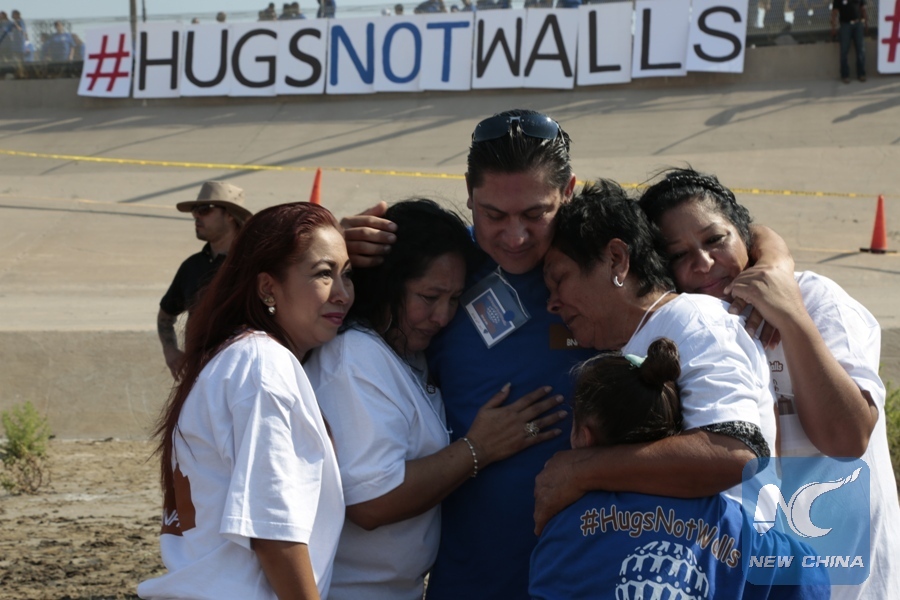
File Photo: Members of a family hug each other during the event "Hugs not Walls" at the riverbed of the Rio Grande river at the border between Mexico and the United States in Juarez, Mexico, on June 24, 2017. (Xinhua/David Peinado)
by Huang Heng
LOS ANGELES, Oct. 26 (Xinhua) -- U.S. Customs and Border Protection (CBP) announced Thursday that eight different prototypes of border wall proposed by President Donald Trump had been constructed and the testing work would begin very soon.
For the first time, U.S. CBP Acting Deputy Commissioner Ronald Vitiello went on a tour of the walls, each of which is approximately 30 feet (9.1 meters) high and 25 feet (7.6 meters) wide.
Half of the eight prototypes are made entirely of concrete and others are made of non-concrete materials at the site, east of the Otay Mesa border crossing, 220 km south of Los Angeles.
"The thing I'm most impressed with is the scale," Vitiello said in a one-hour video clip posted by FOX 5 news channel. The prototypes are much higher than the wall which has been installed along the border for years, which is about 3 meters high.
"We are committed to securing our border and that includes constructing border walls. Our multi-pronged strategy to ensure the safety and security of the American people includes barriers, infrastructure, technology and people," said Vitiello.
"Moving forward with the prototypes enables us to continue to incorporate all the tools necessary to secure our border," he added.
Four construction companies from the states of Alabama, Arizona, Texas and Mississippi were selected to build the prototypes last month, and each of them was awarded roughly 400,000 to 500,000 U.S. dollars.
After Thursday's show, officials will wait 30 days for the concrete to settle and then spend 30 to 60 days evaluating each prototype. They will wield sledgehammers, torches, pickaxes and battery-operated tools to test the strength of each wall and check how well the walls can prevent digging, climbing and any other strategies to break through.
During the testing period, Vitiello said, workers would try to answer basic questions about the possibilities of climbing or digging through the walls.
Trump promised during his presidential campaign that his administration would build a wall along the border with Mexico to stop illegal immigration and curb the crime rate in the United States.
However, his opponents said building the border wall is xenophobic and racist. California's Attorney General Xavier Becerra filed a lawsuit against the Trump administration's plan of building a wall along the border between the United States and Mexico, especially the replacement of barriers with walls in the Southern California city of San Diego and another California border city, Calexico.
On behalf of the Golden State, Becerra listed many defendants in the 53-page indictment, including the United States of America, the United States Department of Homeland Security (DHS), former DHS Secretary John Kelly, acting DHS Secretary Elaine Duke, the CBP and the acting CBP Commissioner Kevin K. McAleenan.
The complaint accused them of violating the U.S. Constitution, failing to comply with federal and state environmental laws, and resorting to a federal statute that does not authorize the proposed projects.
Another obstacle for Trump's border wall plan is budget.
There are already around 650 miles (1,046 km) of fencing along the 2,000 mile- (3,219 km) long border between the two countries, according to a report issued by the DHS.
Building a border wall like Trump has envisioned would cost the country about 21.6 billion dollars and take three and a half years.
Trump has asked Congress for 1.6 billion dollars for the first installment of his wall. It would replace 14 miles (22.5 km) in San Diego of California and build 60 miles (96.6 km) in Texas' Rio Grande Valley, the busiest corridor for illegal crossings.
But except for the money for the prototypes, which came from 20 million dollars that Congress authorized the DHS to pull in the budget earlier this year, Congress has not yet authorized any further money to actually build more walls.
The CBP has yet to receive funding to build a full-scale model of the wall, Vitiello said, but insisted that the authority would continue its work to determine what type of walls should be built in the various sections of the border.
The information gained from the prototype testing process will not be wasted, he said.

